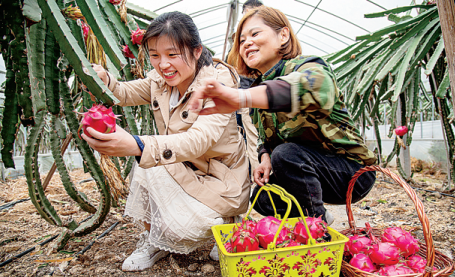

To date, half of the resort's employees are local villagers.
The buildings and decorations go beyond local requirements for environmental protection, says Chen Kong, who is in charge of the operation of the facility.
The stone used in the construction is locally sourced, and wooden materials are certified by the Forest Stewardship Council, an international nonprofit organization that promotes responsible management of the world's forests.
"During our team building events, we'll arrange for employees to go out and clean up the garbage discarded by tourists," Chen says.
This is all part of Trip.com Group's plan to set up a 1 billion yuan fund to build model destinations in the country's rural areas. In particular, 10 high-end rural retreats are at the heart of the strategy.
A total of 100 tourism villages and 10,000 rural tourism staff will be developed over the next five years, according to the online travel agency.
The June legislation has also made the Chinese Farmers' Harvest Festival a statutory holiday on the day of the autumn equinox, which usually falls in September, in an attempt to vitalize rural culture.
Modern agricultural exhibitions and rural food appreciation events are expected to draw many visitors, experts say.
The lively and popular activities will stimulate the passion of the farmers and residents, says Ma Youxiang, vice-minister of the agriculture and rural affairs.
Last year's celebrations covered major events along the Yangtze River Economic Belt on Sept 23, and integrated farming culture, as well as displaying cultural resources with local and ethnic characteristics.
Cultural activities such as farmers' concerts, rural photography, calligraphy and painting were in place.
In 2019, the rural tourism sector saw 3.3 billion traveler visits, with operating revenue exceeding 850 billion yuan, according to the Ministry of Agriculture and Rural Affairs. It has shown a strong recovery since the downturn caused by the pandemic.
In the first six months of last year, the number of tourists to Beijing's rural areas recovered to 66.1 percent of that of the same period in 2019, and business revenue has recovered to some 90 percent, according to the local authority.
At a national promotion meeting for high-quality rural industry development by the ministry in March last year, it was announced that the country will strive to achieve more than 4 billion travel visits to rural villages by 2025, with operating revenue breaking 1.2 trillion yuan. It is expected to benefit more than 15 million people.
Such promises have seen other tour players make inroads in rural tourism development.
The culture and tourism conglomerate Overseas Chinese Town Group has deepened strategic cooperation with rural areas in Guizhou, Sichuan and Gansu provinces to improve local folk customs and the local environment, as well as tap into local culture and tourism resources.
The OCT Group has developed about 30 distinctive rural projects across the country, including the Beijing-Tianjin-Hebei region, the Yangtze River Delta, Hainan and Yunnan provinces.
Those scenic spots have received 40 million tourist visits annually on average, bringing 160,000 people out of poverty, according to OCT.
Since 2016, at Zhongliao village in Hainan, local ethnic Li elements have been retained as part of the construction of a pastoral getaway and art performance venue by the group.